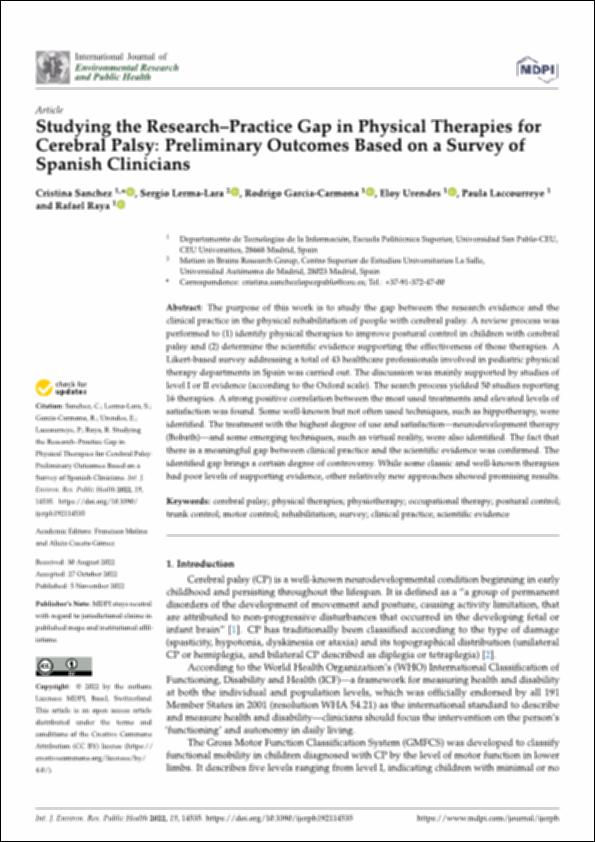Por favor, use este identificador para citar o enlazar este ítem:
http://hdl.handle.net/10637/15039Studying the Research-Practice Gap in Physical Therapies for Cerebral Palsy: Preliminary Outcomes Based on a Survey of Spanish Clinicians
| Título : | Studying the Research-Practice Gap in Physical Therapies for Cerebral Palsy: Preliminary Outcomes Based on a Survey of Spanish Clinicians |
| Autor : | Sánchez López de Pablo, Cristina Lerma-Lara, Sergio García Carmona, Rodrigo Urendes, Eloy Laccourreye, Paula Raya López, Rafael |
| Materias: | cerebral palsy; clinical practice; motor control; occupational therapy; physical therapies; physiotherapy; postural control; rehabilitation; scientific evidence; survey; trunk control |
| Editorial : | MPDI |
| Citación : | Sanchez C, Lerma-Lara S, Garcia-Carmona R, Urendes E, Laccourreye P, Raya R. Studying the Research-Practice Gap in Physical Therapies for Cerebral Palsy: Preliminary Outcomes Based on a Survey of Spanish Clinicians. Int J Environ Res Public Health. 2022 Nov 5;19(21):14535. doi: 10.3390/ijerph192114535. PMID: 36361414; PMCID: PMC9657953. |
| Resumen : | The purpose of this work is to study the gap between the research evidence and the clinical practice in the physical rehabilitation of people with cerebral palsy. A review process was performed to (1) identify physical therapies to improve postural control in children with cerebral palsy and (2) determine the scientific evidence supporting the effectiveness of those therapies. A Likert-based survey addressing a total of 43 healthcare professionals involved in pediatric physical therapy departments in Spain was carried out. The discussion was mainly supported by studies of level I or II evidence (according to the Oxford scale). The search process yielded 50 studies reporting 16 therapies. A strong positive correlation between the most used treatments and elevated levels of satisfaction was found. Some well-known but not often used techniques, such as hippotherapy, were identified. The treatment with the highest degree of use and satisfaction-neurodevelopment therapy (Bobath)-and some emerging techniques, such as virtual reality, were also identified. The fact that there is a meaningful gap between clinical practice and the scientific evidence was confirmed. The identified gap brings a certain degree of controversy. While some classic and well-known therapies had poor levels of supporting evidence, other relatively new approaches showed promising results. |
| URI : | http://hdl.handle.net/10637/15039 |
| Derechos: | http://creativecommons.org/licenses/by-nc-nd/4.0/deed.es OpenAccess |
| ISSN : | 1660-4601 |
| Fecha de publicación : | 2022 |
| Centro : | Universidad San Pablo-CEU |
| Aparece en las colecciones: | Escuela de Politécnica Superior |
Los ítems de DSpace están protegidos por copyright, con todos los derechos reservados, a menos que se indique lo contrario.


